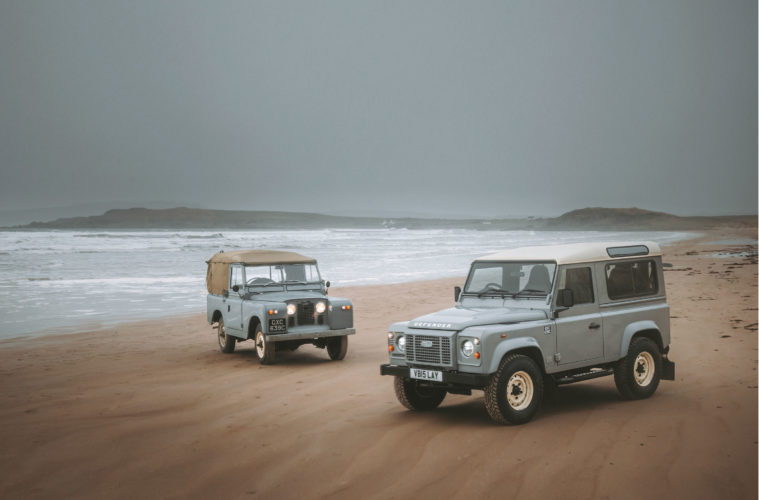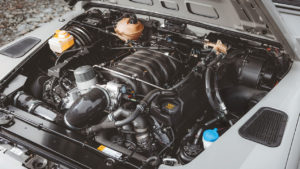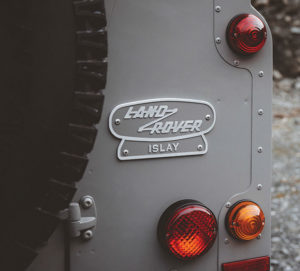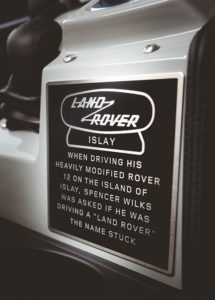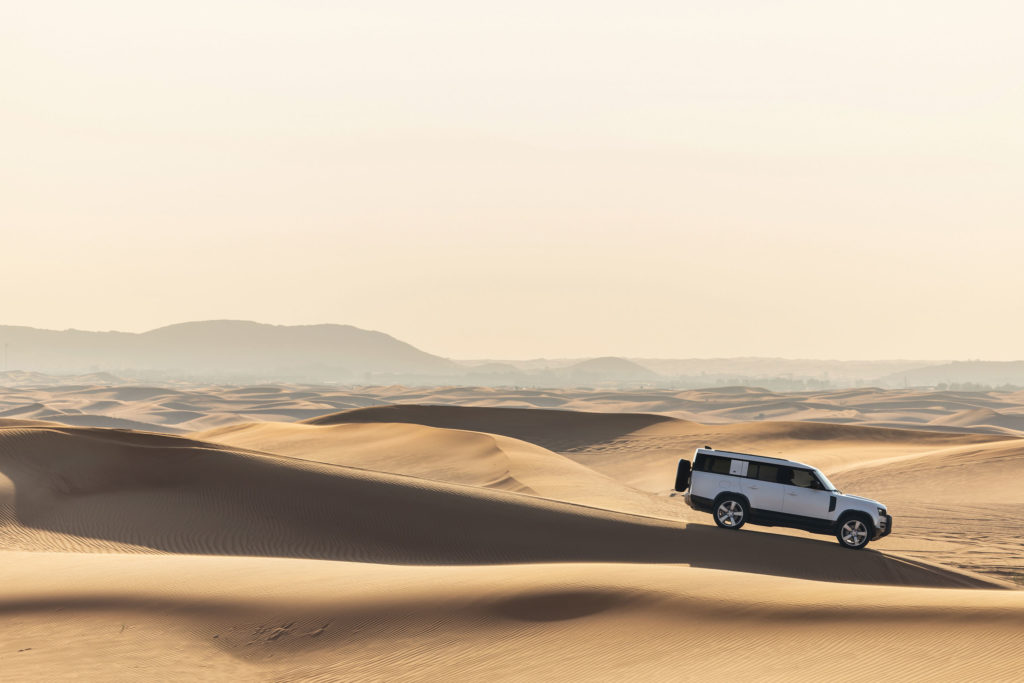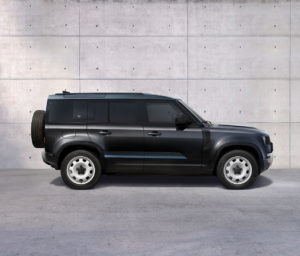JLR has announced these 2023½ updates to existing models and a wonderful addition for UK and RoW enthusiasts.
Defender Works V8 Islay Edition (L316)
With apologies to Grease, “You’re the one that I want!” Sadly, North American enthusiasts can’t import this “newest” L316 Defender.
Back on May 2, Jaguar Land Rover Classic presented the Defender Works V8 Islay Edition as the first heritage-themed edition Defender.
A total of 30 Station Wagons (17 Defender 90s, 13 Defender 110s) will be produced, each with a 5.0L V8 (405 hp) sending power through an 8-speed ZF transmission. A special suspension upgrade kit and handling upgrade kit have been engineered to accommodate the extra power and speed. Each one comes from a 2012–2016 donor vehicle.
I asked Mike Bishop, Jaguar Land Rover Classic, to provide some background on its creation.
“This vehicle is especially personal to me,” Mike wrote, “as I put forward the initial concept brief in 2021. When the initial Defender Works V8 70th Edition was created, the vehicle supported the Defender line while the new model awaited release. It really did look more like a then-current production model.”
“With the L663 Defender launch, we at Classic could explore further some of the great stories and themes of the past, most noticeably up to now with the initial Defender Works V8 Trophy edition in Eastnor Yellow (very similar in color to the earlier Sandglow). After the Defender Trophy builds, colleagues invited me to gather my ideas together for a Works V8 Edition vehicle.”
“The Islay Land Rover story had always really struck me as such a fantastic tale of using vehicles in remote locations that inspired ingenuity and creativity to simply make them fitter for the location quickly and easily — in the case of Spencer Wilks initially using Rover cars it came to inspire the name ‘Land Rover’ and then later still helped develop the original Land Rovers we know and love.”
“When traveling in our Land Rovers today, whatever era or model we more often like that balance of what Spencer had helped foresee — a versatile, practical vehicle that could be used for any task and could fit into any set of circumstances. His last Land Rover, his Series IIA GXC639C (part of the JLR Classic collection) came with early development sequential wipers fitted for him to test as he got about his day at his Laggan Estate on Islay, one of the Inner Hebrides in Scotland.”
“With Land Rover Classic has started looking at some great stories with the Defender Works V8 Trophy edition, I thought that a Defender Works V8 based on GXC, Spencer’s Series IIA, how he used that vehicle along with the fantastic celebration of the Land Rover name being coined on his estate on Islay for the 75th anniversary, would be a great one. My colleagues most certainly agreed on this story, pretty much instantly. With the brief set, I let them get on with it. The resulting Defender is true to Spen King’s spirit.”
Defender 90 (L663)
The upgrades to the Defender 90 focus on interior enhancements. When we road-tested the Defender 90 [See Winter 2022 issue –ed.], we noted the glacial pace of the motorized front seat when trying to access the rear seats. Now, the Defender 90 has much-improved access to the rear seats with a “parachute grab handle,” a quick fold-and-slide first-row passenger seat, and a new 40:20:40 folding seat with a center armrest. To answer the other concern about the lack of a flat floor, there’s a standard load space floor tray with internal storage and D-rings to lash down gear.
Defender 110 (L663)
Back in 1982, Land Rover introduced the “County” Station Wagon, featuring a plusher interior, a full-length headliner, and the ubiquitous “go faster” stripes. For 2023 ½, JLR announced the “County Exterior Pack,” which can be ordered on every 110 models. The County graphics return, along with a new eye-catching County graphic on the tread plate. Color choices include the all-too-familiar Fuji White, Santorini Black, and my personal favorite, Tasman Blue with a contrasting white top. Inside, you can personalize your Defender 110 with new interior seat coverings, veneers and color schemes.
The Defender 110 can now appear in your driveway with the optional tried-and-true 5.0L V8 P500 (493 hp, 450 lb-ft of torque). With the higher power, Land Rover includes suspension upgrades (springs, larger anti-roll bars, different shocks, and larger, 15-inch front brakes and 22-inch wheels. (There’s an optional 20-inch wheel with proper tires for off-roading.)
Defender 130 Outbound (L663)
When we road tested the Defender 130 in the Winter/Spring issue, we suggested a “Utility Pack,” which would “delete the third row of seats, add the rubberized flooring from the 90, removable and washable carpeting, rugged and durable seat fabrics and the off-road-oriented features of the Adventure and Explorer packs. Oh, and proper tires, too.”
The Outbound moves in that direction. It features two-row [5] seating only, durable rubber floor matting, “nearly flat” rear load space, Discovery-like cargo nets, a satin protective film to avoid those “pinstripes,” durable interior fabric (or leather), 20” wheels to improve tire choices, 88.5 cu ft of cargo space (46 cu ft using the rear seat) with a towing capacity of 8,200 lbs.
It will be available only with the P400 Ingenium 3.0L 6-cylinder (395 hp, 406 lb-ft torque). Body paint colors include Santorini Black, Carpathian Grey, Eiger Grey, and Fuji White.
Defender 130 V8 (L663)
This edition also pays tribute to the V8 heritage of Land Rover models, using the same 5.0L supercharged engine to produce 0-60 mph in 5.4 seconds with 493 hp and 450 lb-ft of torque. Enthusiasts will enjoy the sound of the quad outboard-mounted exhausts and the brightness of the sliding panoramic roof. It’s available only as a three-row seat version and features an array
of heated seats [all rows] in leather with suede cloth, and a four-zone climate control system.
With JLR seeking to create a stand-alone Defender brand, these models will expand the line-up without major investment. We hope that JLR won’t forget that the country club and suburban mall didn’t constitute the only reasons that enthusiasts sought out Defenders.
It’s time to create a “Work Pack” for people whose interests range from exploration and adventure to commercial/personal farming, logging, and construction.
2023 Range Rover SWB
When one chooses to drive 800 miles round trip through New Jersey, New York, Pennsylvania, Maryland, West Virginia, Virginia and back, one will enjoy the vistas of the Appalachian, Shenandoah and Blue Ridge Mountains. A 2023 Range Rover provides the perfect vehicle for the 6.5-hour trip: eminently comfortable, commanding and serene without removing the joy of driving.
When one realizes that much of the trip takes place on I-81, known as “one of the most dangerous interstates in the country,” with an average of 2,000 crashes in a recent year, the desire for a 2023 Range Rover for the voyage makes even more sense.
JLR complied with my request – or more accurately, with my shameless begging and whining – and loaned me a 2023 Range Rover SWB with 8,500 miles on the odometer. With the Ingenium 3.0L mild hybrid straight six, 395 hp and 406 lb ft of torque, power flows through the brilliant ZF 8-speed transmission when in normal drive mode. Move it into Sport mode and the power gushes with the slightest touch of the accelerator.
You’re still in full control. JLR states that this 2023 edition incorporates a new structurally enhanced platform for more rigidity which, when coupled with its air spring suspension, adaptive dampers, 48-volt active anti-roll system and rear-wheel steering, makes it a more-nimble drive than its 5,240 lb curb weight, 118” wheelbase and 198.9” overall length would suggest. The 35.9 ft turning circle and 2.78 turns lock-to-lock steering also made driving the twisty Blue Ridge Parkway a delight. I applaud the drivetrain, suspension and body structure engineer teams for their accomplishments in making this Range Rover so appealing for on-road travel.
Equally important to me, the Range Rover remains a driver’s vehicle. I’m sure the choice of wheel size and tires play a role, but I so enjoyed feeling the road conditions beneath the wheels without subjecting myself to unwanted noise, vibration and harshness. I’ve driven Range Rover Classics, a P38A, and a couple of L322 Range Rovers. Time in each of the previous four generations left me wondering how much better a Range Rover would ride and handle. The answer from this fifth generation is a resounding, much better!
If you need to tow 7,716 lbs. or wade through 35 inches of water, go right ahead. The 11.6” ground clearance off-road, coupled with an approach angle of 34.7 degrees, a departure angle of 29.0 degrees and a ramp angle of 27.7 degrees, should substantially reduce the chances of you getting hung up off-road.
Standing outside and staring at the Range Rover, my mouth fell agape at its carved-out-of-a-billet lines, perfect proportions, apparent lack of creases or chamfers and 0.30 Cd. When you touch the key fob, the retractable door handles elevate to meet your hand. The substantial door moves out with ease and closes its last few inches with an electric assist; the same is true for the clamshell tailgate. Once inside the Range Rover, its infinitely adjustable seats, which offer a massage feature, coupled with the fully adjustable steering wheel, enabled me to find the perfect driving position. Just as importantly, the seating allowed me to view the corners of the bonnet so I could become aware of the center of the vehicle as I maneuvered it around obstacles.
I remain annoyed that the center screen of every car and truck now makes me feel like I’m in the front row at a drive-in movie, but I realize I lost that battle to NHTSA and consumer demand a decade ago. At least the Range Rover’s PIVI system responds quickly to every input, and JLR has left just enough buttons and knobs on the fascia and steering wheel so I could keep my eyes on the road.
The combination of the seat design and the overall ergonomics, coupled with the elegant leather, wood and soft textures of the interior, left me sighing every time I stepped into it. The interior certainly resonated with enthusiasts at Rovers at Wintergreen. Once I offered the opportunity, many men, women and children climbed into the Range Rover – and climbed out only reluctantly.
My long weekend and 800 miles with the Range Rover, even with its mileage and smaller option list, left me understanding why people will wait 3–6 months for their Range Rover. (In the UK, press reports note that the wait times run 6-12 months.) I’ve made trips along the same routes and duration in my 25-year-old Discovery I — even in my Series IIA 109” – and arrived tired (Discovery I) or exhausted (Series IIA). With this Range Rover drive, let me add the feelings of exhilaration and awe.
